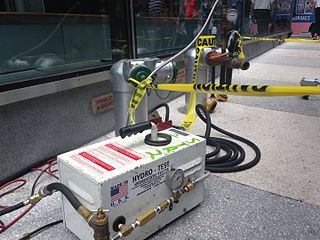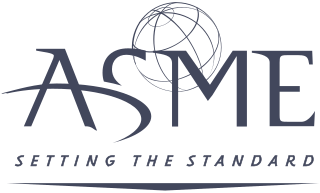
A boiler is a closed vessel in which fluid is heated. The fluid does not necessarily boil. The heated or vaporized fluid exits the boiler for use in various processes or heating applications, including water heating, central heating, boiler-based power generation, cooking, and sanitation.

A hydrostatic test is a way in which pressure vessels such as pipelines, plumbing, gas cylinders, boilers and fuel tanks can be tested for strength and leaks. The test involves filling the vessel or pipe system with a liquid, usually water, which may be dyed to aid in visual leak detection, and pressurization of the vessel to the specified test pressure. Pressure tightness can be tested by shutting off the supply valve and observing whether there is a pressure loss. The location of a leak can be visually identified more easily if the water contains a colorant. Strength is usually tested by measuring permanent deformation of the container.

The American Society of Mechanical Engineers (ASME) is an American professional association that, in its own words, "promotes the art, science, and practice of multidisciplinary engineering and allied sciences around the globe" via "continuing education, training and professional development, codes and standards, research, conferences and publications, government relations, and other forms of outreach." ASME is thus an engineering society, a standards organization, a research and development organization, an advocacy organization, a provider of training and education, and a nonprofit organization. Founded as an engineering society focused on mechanical engineering in North America, ASME is today multidisciplinary and global.

A pressure vessel is a container designed to hold gases or liquids at a pressure substantially different from the ambient pressure.
Dye penetrant inspection (DP), also called liquid penetrate inspection (LPI) or penetrant testing (PT), is a widely applied and low-cost inspection method used to check surface-breaking defects in all non-porous materials. The penetrant may be applied to all non-ferrous materials and ferrous materials, although for ferrous components magnetic-particle inspection is often used instead for its subsurface detection capability. LPI is used to detect casting, forging and welding surface defects such as hairline cracks, surface porosity, leaks in new products, and fatigue cracks on in-service components.

A boilermaker is a tradesperson who fabricates steels, iron, or copper into boilers and other large containers intended to hold hot gas or liquid, as well as maintains and repairs boilers and boiler systems.
The Pressure Equipment Directive (PED) 2014/68/EU of the EU sets out the standards for the design and fabrication of pressure equipment generally over one liter in volume and having a maximum pressure more than 0.5 bar gauge. It also sets the administrative procedures requirements for the "conformity assessment" of pressure equipment, for the free placing on the European market without local legislative barriers. It has been mandatory throughout the EU since 30 May 2002, with 2014 revision fully effective as of 19 July 2016. The standards and regulations regarding pressure vessels and boiler safety are also very close to the US standards defined by the American Society of Mechanical Engineers (ASME). This enables most international inspection agencies to provide both verification and certification services to assess compliance to the different pressure equipment directives. From the pressure vessel manufactures PED does not generally require a prior manufacturing permit/certificate/stamp as ASME does.
Welder certification, is a process which examines and documents a welder's capability to create welds of acceptable quality following a well defined welding procedure.

A Welding Procedure Specification (WPS) is a formal document describing welding procedures. It is an internal document used by welding companies to instruct welders on how to achieve quality production welds that meet all relevant code requirements. Each company typically develops their own WPS for each material alloy and for each welding type used. Specific codes and/or engineering societies are often the driving force behind the development of a company's WPS. A WPS is supported by a Procedure Qualification Record, a formal record of a test weld performed and rigorously tested to ensure that the procedure will produce a good weld. Individual welders are certified with a qualification test documented in a Welder Qualification Test Record (WQTR) that shows they have the understanding and demonstrated ability to work within the specified WPS.
Maximum Allowable Operating Pressure or MAOP is a pressure limit set, usually by a government body, which applies to compressed gas pressure vessels, pipelines, and storage tanks. For pipelines, this value is derived from Barlow's Formula, which takes into account wall thickness, diameter, allowable stress, and a safety factor.
ASME BPE is an international Standard developed as an aid for the design and construction of equipment intended for use in the manufacturing of biopharmaceuticals. The standard is approved as an American National Standard by the ASME Board of Pressure Technologies. The first edition of this Standard was approved as an American National Standard on May 20, 1997. The most recent edition was approved by ANSI on March 21, 2022.
EN 13445 - Unfired Pressure Vessels is a standard that provides rules for the design, fabrication, and inspection of pressure vessels
ASME NQA-1 is an industry consensus standard created and maintained by the American Society of Mechanical Engineers (ASME). The latest edition was issued on June 30, 2022 (NQA-1-2022). However, the most commonly used version in the supply chain is NQA-1-2008 with the NQA-1a-2009 addendum. Any organization submitting an application for a new design are using the NQA-1-2015 edition. This is the case because these are the versions endorsed by the NRC.
MDMT is one of the design conditions for pressure vessels engineering calculations, design and manufacturing according to the ASME Boilers and Pressure Vessels Code. Each pressure vessel that conforms to the ASME code has its own MDMT, and this temperature is stamped on the vessel nameplate. The precise definition can sometimes be a little elaborate, but in simple terms the MDMT is a temperature arbitrarily selected by the user of type of fluid and the temperature range the vessel is going to handle. The so-called arbitrary MDMT must be lower than or equal to the CET and must be higher than or equal to the (MDMT)M.
The National Board of Boiler and Pressure Vessel Inspectors (NBBI) is composed of chief boiler and pressure vessel inspectors representing states, cities, and provinces enforcing pressure equipment laws and regulations. Created to prevent death, injury and destruction, these laws and regulations represent the collective input of National Board members.
Metal testing is a process or procedure used to check composition of an unknown metallic substance. There are destructive processes and nondestructive processes. Metal testing can also include, determining the properties of newly forged metal alloys. With many chemical-property databases readily available, identification of unmarked pure, common metals can be a quick and easy process. Leaving the original sample in complete, re-usable condition. This type of testing is nondestructive. When working with alloys of metals however, to determine the exact composition, could result in the original sample being separated into its starting materials, then measured and calculated. After the components are known they can be looked up and matched to known alloys. The original sample would be destroyed in the process. This type of testing is destructive.
ASME is a non-profit organization that continues to develop and maintains nearly 600 codes and standards in a wide range of disciplines. Some of which includes the Boiler and Pressure Vessel Code (BPVC), Elevators and Escalators, Piping and Pipelines, Bioprocessing Equipment (BPE), Nuclear Facility Applications (NQA), Process Performance Test Codes (PTC), and Valves, Flanges, Fittings and Gaskets (B16).
Post weld heat treatment (PWHT) is a controlled process in which a material that has been welded is reheated to a temperature below its lower critical transformation temperature, and then it is held at that temperature for a specified amount of time. It is often referred to as being any heat treatment performed after welding; however, within the oil, gas, petrochemical and nuclear industries, it has a specific meaning. Industry codes, such as the ASME Pressure Vessel and Piping Codes, often require mandatory performance of PWHT on certain materials to ensure a safe design with optimal mechanical and metallurgical properties.

Piping systems in U.S. nuclear power plants that are relied on for the safe shutdown of the plant are typically constructed to Section III of the American Society of Mechanical Engineers (ASME) Boiler and Pressure Vessel (B&PV) Code. The materials allowed by the ASME B&PV Code have been historically limited to metallic materials only. Due to the success of high density polyethylene (HDPE) in other industries, nuclear power plants in the U.S. have expressed interest in using HDPE piping in ASME B&PV Code applications. In 2008, the first U.S. nuclear power plant was approved by the United States Nuclear Regulatory Commission to install HDPE in an ASME B&PV Code safety-related system. Since then, the rules for using HDPE have been integrated into the 2015 Edition and 2017 Edition of the ASME B&PV Code. The NRC approved of the 2015 and 2017 Editions in 2020.






